Faculty of Technology: Analyzing a Sustainable Business Report
VerifiedAdded on 2022/08/18
|7
|1463
|14
Report
AI Summary
This report analyzes various approaches to sustainable business development, including the Triple Bottom Line, Five Capital, Natural Capitalism, Cradle to Cradle, Circular Economy, and Balanced Scorecard. The report applies these concepts to case studies of the automotive industry, specifically focusing on the sustainable initiatives of General Motors (Cradle to Cradle approach) and Toyota Motor Corporation (Triple Bottom Line approach). General Motors' reuse of materials and waste reduction strategies, along with Toyota's environmental challenges and hybrid vehicle initiatives, are examined to illustrate practical applications of sustainability principles. The report highlights how these companies integrate sustainability into their operations, contributing to environmental protection and business success, and provides references for further research.
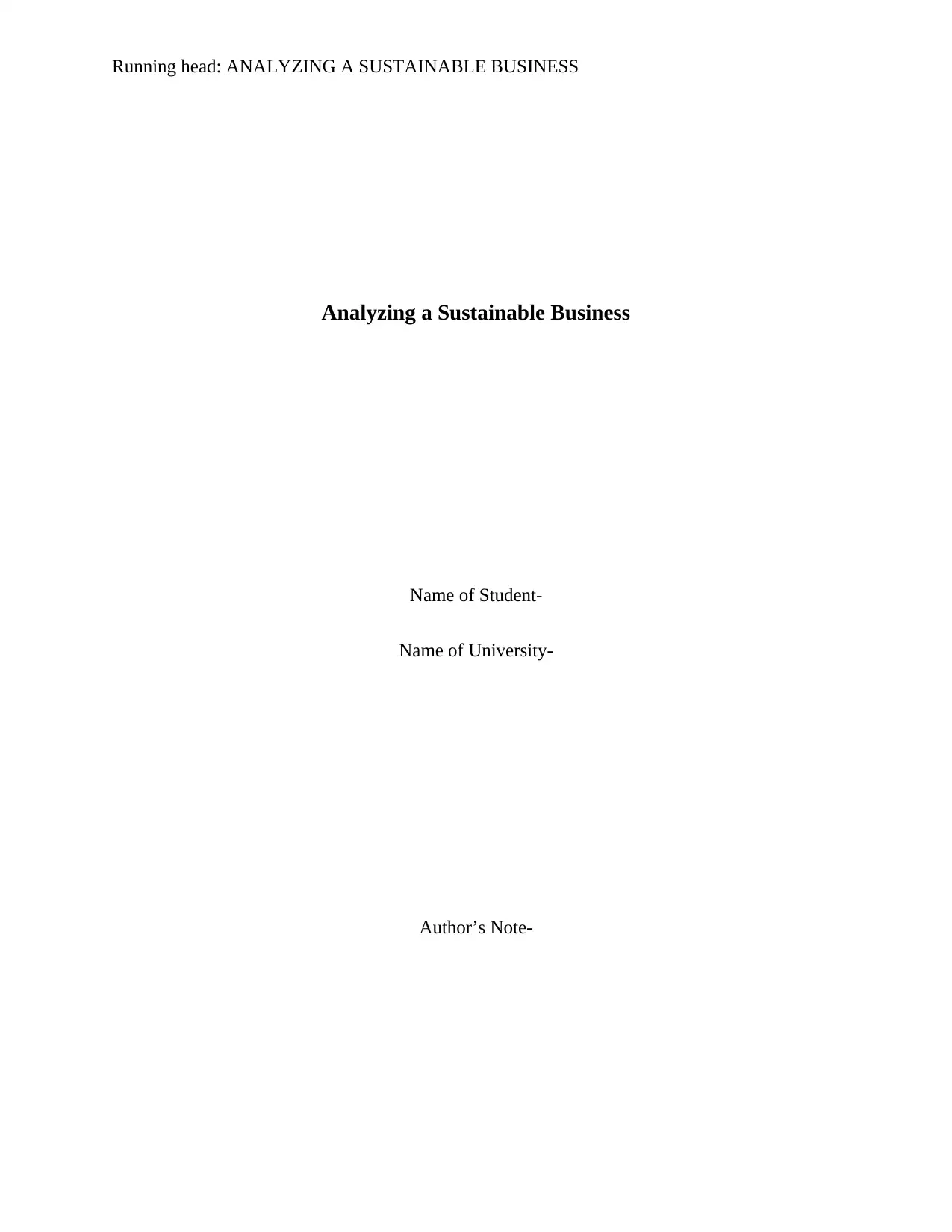
Running head: ANALYZING A SUSTAINABLE BUSINESS
Analyzing a Sustainable Business
Name of Student-
Name of University-
Author’s Note-
Analyzing a Sustainable Business
Name of Student-
Name of University-
Author’s Note-
Paraphrase This Document
Need a fresh take? Get an instant paraphrase of this document with our AI Paraphraser
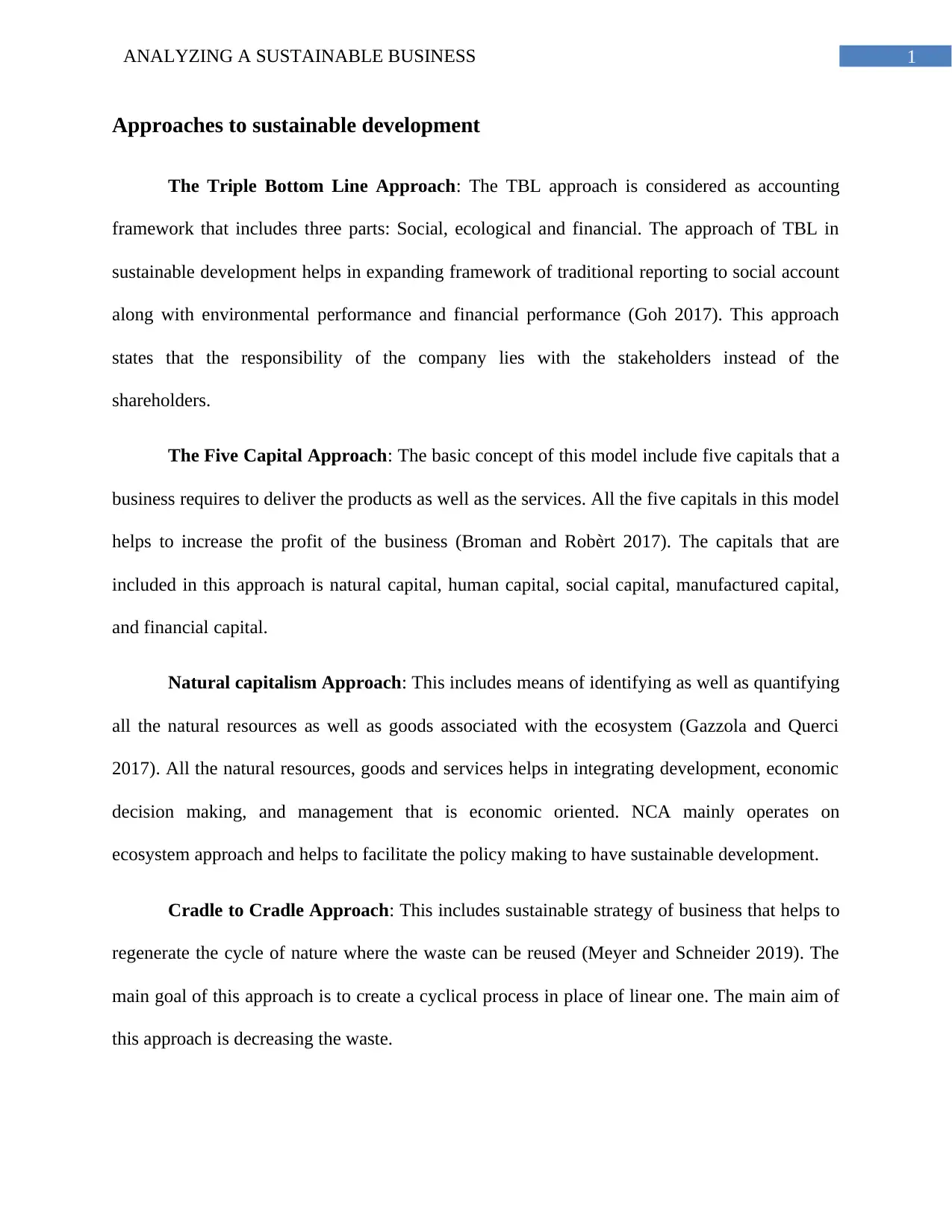
1ANALYZING A SUSTAINABLE BUSINESS
Approaches to sustainable development
The Triple Bottom Line Approach: The TBL approach is considered as accounting
framework that includes three parts: Social, ecological and financial. The approach of TBL in
sustainable development helps in expanding framework of traditional reporting to social account
along with environmental performance and financial performance (Goh 2017). This approach
states that the responsibility of the company lies with the stakeholders instead of the
shareholders.
The Five Capital Approach: The basic concept of this model include five capitals that a
business requires to deliver the products as well as the services. All the five capitals in this model
helps to increase the profit of the business (Broman and Robèrt 2017). The capitals that are
included in this approach is natural capital, human capital, social capital, manufactured capital,
and financial capital.
Natural capitalism Approach: This includes means of identifying as well as quantifying
all the natural resources as well as goods associated with the ecosystem (Gazzola and Querci
2017). All the natural resources, goods and services helps in integrating development, economic
decision making, and management that is economic oriented. NCA mainly operates on
ecosystem approach and helps to facilitate the policy making to have sustainable development.
Cradle to Cradle Approach: This includes sustainable strategy of business that helps to
regenerate the cycle of nature where the waste can be reused (Meyer and Schneider 2019). The
main goal of this approach is to create a cyclical process in place of linear one. The main aim of
this approach is decreasing the waste.
Approaches to sustainable development
The Triple Bottom Line Approach: The TBL approach is considered as accounting
framework that includes three parts: Social, ecological and financial. The approach of TBL in
sustainable development helps in expanding framework of traditional reporting to social account
along with environmental performance and financial performance (Goh 2017). This approach
states that the responsibility of the company lies with the stakeholders instead of the
shareholders.
The Five Capital Approach: The basic concept of this model include five capitals that a
business requires to deliver the products as well as the services. All the five capitals in this model
helps to increase the profit of the business (Broman and Robèrt 2017). The capitals that are
included in this approach is natural capital, human capital, social capital, manufactured capital,
and financial capital.
Natural capitalism Approach: This includes means of identifying as well as quantifying
all the natural resources as well as goods associated with the ecosystem (Gazzola and Querci
2017). All the natural resources, goods and services helps in integrating development, economic
decision making, and management that is economic oriented. NCA mainly operates on
ecosystem approach and helps to facilitate the policy making to have sustainable development.
Cradle to Cradle Approach: This includes sustainable strategy of business that helps to
regenerate the cycle of nature where the waste can be reused (Meyer and Schneider 2019). The
main goal of this approach is to create a cyclical process in place of linear one. The main aim of
this approach is decreasing the waste.
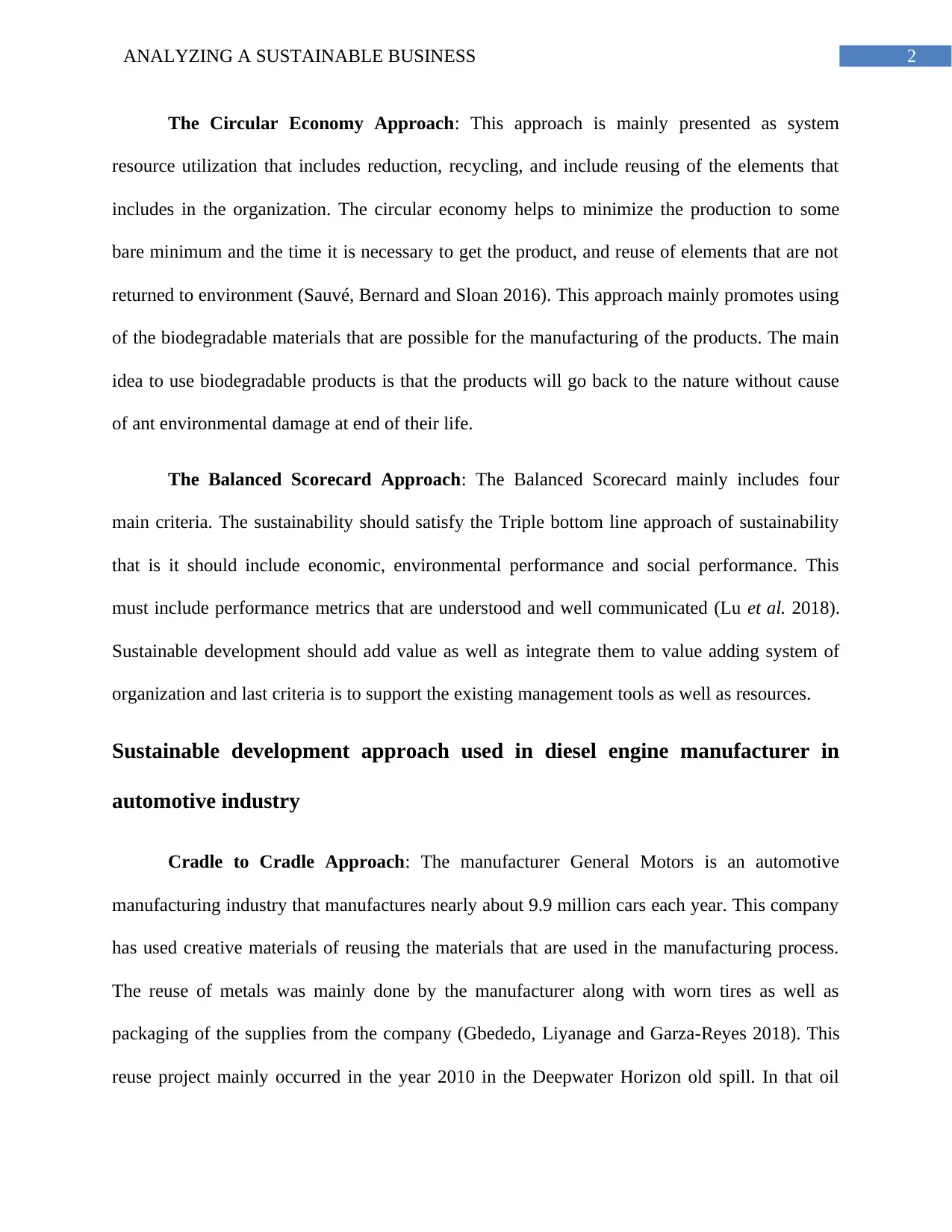
2ANALYZING A SUSTAINABLE BUSINESS
The Circular Economy Approach: This approach is mainly presented as system
resource utilization that includes reduction, recycling, and include reusing of the elements that
includes in the organization. The circular economy helps to minimize the production to some
bare minimum and the time it is necessary to get the product, and reuse of elements that are not
returned to environment (Sauvé, Bernard and Sloan 2016). This approach mainly promotes using
of the biodegradable materials that are possible for the manufacturing of the products. The main
idea to use biodegradable products is that the products will go back to the nature without cause
of ant environmental damage at end of their life.
The Balanced Scorecard Approach: The Balanced Scorecard mainly includes four
main criteria. The sustainability should satisfy the Triple bottom line approach of sustainability
that is it should include economic, environmental performance and social performance. This
must include performance metrics that are understood and well communicated (Lu et al. 2018).
Sustainable development should add value as well as integrate them to value adding system of
organization and last criteria is to support the existing management tools as well as resources.
Sustainable development approach used in diesel engine manufacturer in
automotive industry
Cradle to Cradle Approach: The manufacturer General Motors is an automotive
manufacturing industry that manufactures nearly about 9.9 million cars each year. This company
has used creative materials of reusing the materials that are used in the manufacturing process.
The reuse of metals was mainly done by the manufacturer along with worn tires as well as
packaging of the supplies from the company (Gbededo, Liyanage and Garza-Reyes 2018). This
reuse project mainly occurred in the year 2010 in the Deepwater Horizon old spill. In that oil
The Circular Economy Approach: This approach is mainly presented as system
resource utilization that includes reduction, recycling, and include reusing of the elements that
includes in the organization. The circular economy helps to minimize the production to some
bare minimum and the time it is necessary to get the product, and reuse of elements that are not
returned to environment (Sauvé, Bernard and Sloan 2016). This approach mainly promotes using
of the biodegradable materials that are possible for the manufacturing of the products. The main
idea to use biodegradable products is that the products will go back to the nature without cause
of ant environmental damage at end of their life.
The Balanced Scorecard Approach: The Balanced Scorecard mainly includes four
main criteria. The sustainability should satisfy the Triple bottom line approach of sustainability
that is it should include economic, environmental performance and social performance. This
must include performance metrics that are understood and well communicated (Lu et al. 2018).
Sustainable development should add value as well as integrate them to value adding system of
organization and last criteria is to support the existing management tools as well as resources.
Sustainable development approach used in diesel engine manufacturer in
automotive industry
Cradle to Cradle Approach: The manufacturer General Motors is an automotive
manufacturing industry that manufactures nearly about 9.9 million cars each year. This company
has used creative materials of reusing the materials that are used in the manufacturing process.
The reuse of metals was mainly done by the manufacturer along with worn tires as well as
packaging of the supplies from the company (Gbededo, Liyanage and Garza-Reyes 2018). This
reuse project mainly occurred in the year 2010 in the Deepwater Horizon old spill. In that oil
⊘ This is a preview!⊘
Do you want full access?
Subscribe today to unlock all pages.

Trusted by 1+ million students worldwide
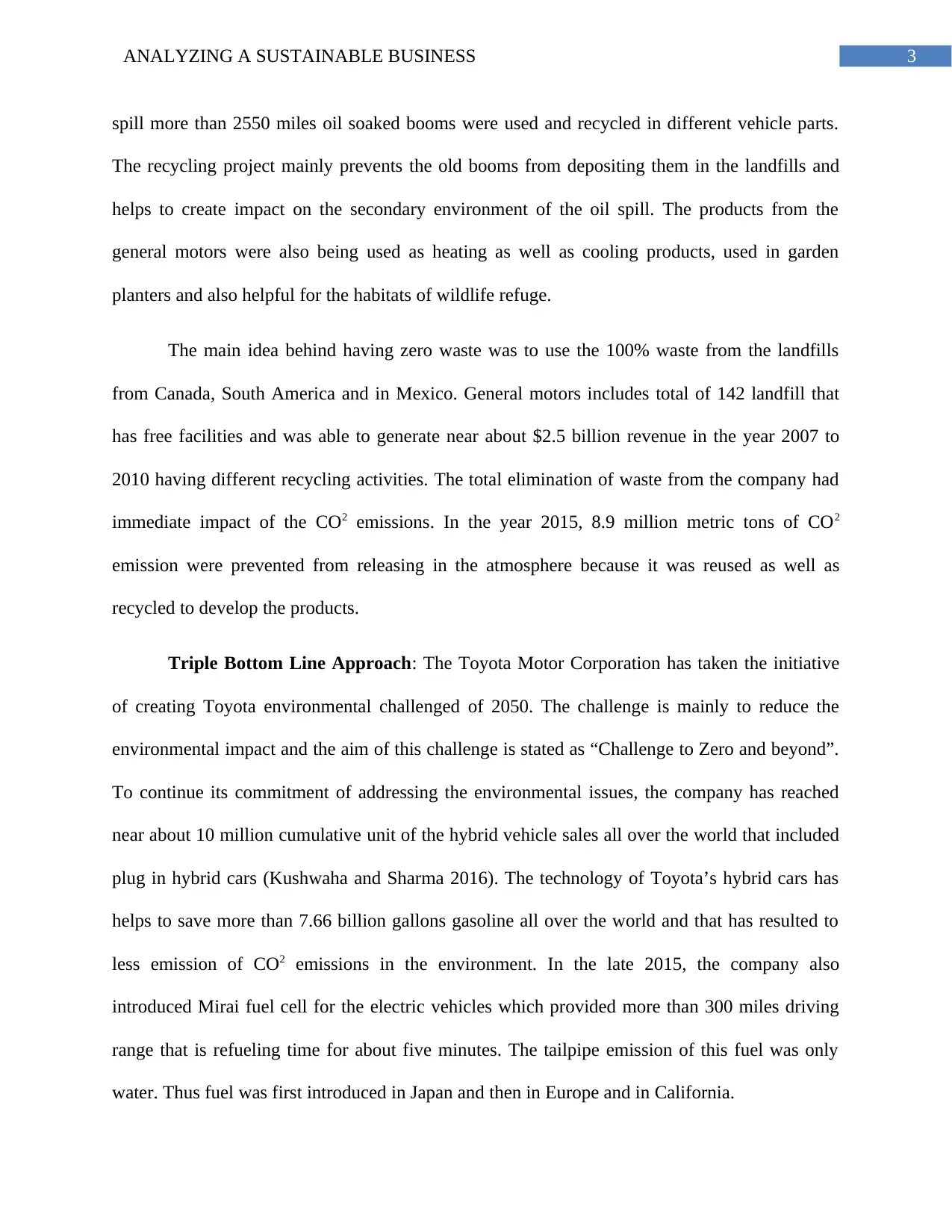
3ANALYZING A SUSTAINABLE BUSINESS
spill more than 2550 miles oil soaked booms were used and recycled in different vehicle parts.
The recycling project mainly prevents the old booms from depositing them in the landfills and
helps to create impact on the secondary environment of the oil spill. The products from the
general motors were also being used as heating as well as cooling products, used in garden
planters and also helpful for the habitats of wildlife refuge.
The main idea behind having zero waste was to use the 100% waste from the landfills
from Canada, South America and in Mexico. General motors includes total of 142 landfill that
has free facilities and was able to generate near about $2.5 billion revenue in the year 2007 to
2010 having different recycling activities. The total elimination of waste from the company had
immediate impact of the CO2 emissions. In the year 2015, 8.9 million metric tons of CO2
emission were prevented from releasing in the atmosphere because it was reused as well as
recycled to develop the products.
Triple Bottom Line Approach: The Toyota Motor Corporation has taken the initiative
of creating Toyota environmental challenged of 2050. The challenge is mainly to reduce the
environmental impact and the aim of this challenge is stated as “Challenge to Zero and beyond”.
To continue its commitment of addressing the environmental issues, the company has reached
near about 10 million cumulative unit of the hybrid vehicle sales all over the world that included
plug in hybrid cars (Kushwaha and Sharma 2016). The technology of Toyota’s hybrid cars has
helps to save more than 7.66 billion gallons gasoline all over the world and that has resulted to
less emission of CO2 emissions in the environment. In the late 2015, the company also
introduced Mirai fuel cell for the electric vehicles which provided more than 300 miles driving
range that is refueling time for about five minutes. The tailpipe emission of this fuel was only
water. Thus fuel was first introduced in Japan and then in Europe and in California.
spill more than 2550 miles oil soaked booms were used and recycled in different vehicle parts.
The recycling project mainly prevents the old booms from depositing them in the landfills and
helps to create impact on the secondary environment of the oil spill. The products from the
general motors were also being used as heating as well as cooling products, used in garden
planters and also helpful for the habitats of wildlife refuge.
The main idea behind having zero waste was to use the 100% waste from the landfills
from Canada, South America and in Mexico. General motors includes total of 142 landfill that
has free facilities and was able to generate near about $2.5 billion revenue in the year 2007 to
2010 having different recycling activities. The total elimination of waste from the company had
immediate impact of the CO2 emissions. In the year 2015, 8.9 million metric tons of CO2
emission were prevented from releasing in the atmosphere because it was reused as well as
recycled to develop the products.
Triple Bottom Line Approach: The Toyota Motor Corporation has taken the initiative
of creating Toyota environmental challenged of 2050. The challenge is mainly to reduce the
environmental impact and the aim of this challenge is stated as “Challenge to Zero and beyond”.
To continue its commitment of addressing the environmental issues, the company has reached
near about 10 million cumulative unit of the hybrid vehicle sales all over the world that included
plug in hybrid cars (Kushwaha and Sharma 2016). The technology of Toyota’s hybrid cars has
helps to save more than 7.66 billion gallons gasoline all over the world and that has resulted to
less emission of CO2 emissions in the environment. In the late 2015, the company also
introduced Mirai fuel cell for the electric vehicles which provided more than 300 miles driving
range that is refueling time for about five minutes. The tailpipe emission of this fuel was only
water. Thus fuel was first introduced in Japan and then in Europe and in California.
Paraphrase This Document
Need a fresh take? Get an instant paraphrase of this document with our AI Paraphraser
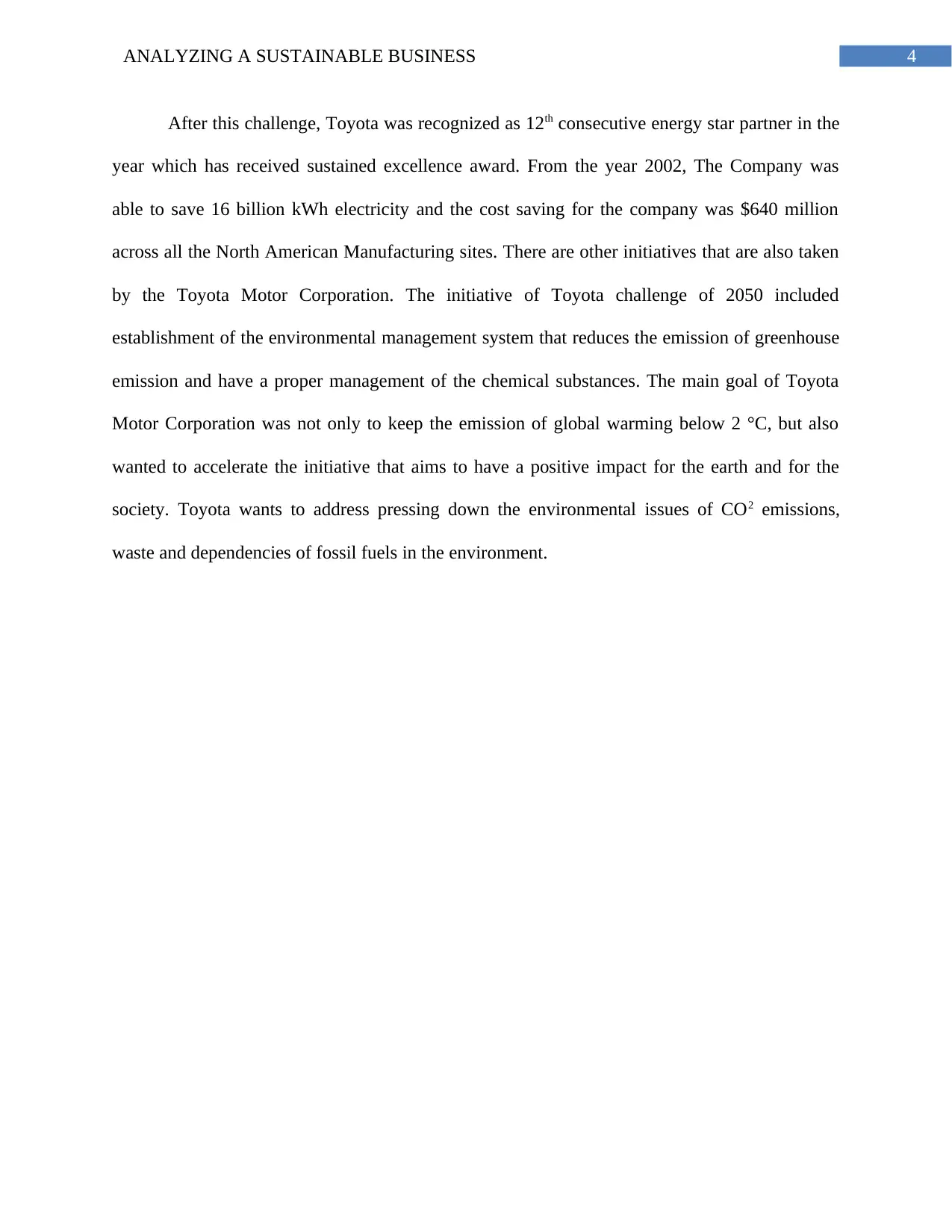
4ANALYZING A SUSTAINABLE BUSINESS
After this challenge, Toyota was recognized as 12th consecutive energy star partner in the
year which has received sustained excellence award. From the year 2002, The Company was
able to save 16 billion kWh electricity and the cost saving for the company was $640 million
across all the North American Manufacturing sites. There are other initiatives that are also taken
by the Toyota Motor Corporation. The initiative of Toyota challenge of 2050 included
establishment of the environmental management system that reduces the emission of greenhouse
emission and have a proper management of the chemical substances. The main goal of Toyota
Motor Corporation was not only to keep the emission of global warming below 2 °C, but also
wanted to accelerate the initiative that aims to have a positive impact for the earth and for the
society. Toyota wants to address pressing down the environmental issues of CO2 emissions,
waste and dependencies of fossil fuels in the environment.
After this challenge, Toyota was recognized as 12th consecutive energy star partner in the
year which has received sustained excellence award. From the year 2002, The Company was
able to save 16 billion kWh electricity and the cost saving for the company was $640 million
across all the North American Manufacturing sites. There are other initiatives that are also taken
by the Toyota Motor Corporation. The initiative of Toyota challenge of 2050 included
establishment of the environmental management system that reduces the emission of greenhouse
emission and have a proper management of the chemical substances. The main goal of Toyota
Motor Corporation was not only to keep the emission of global warming below 2 °C, but also
wanted to accelerate the initiative that aims to have a positive impact for the earth and for the
society. Toyota wants to address pressing down the environmental issues of CO2 emissions,
waste and dependencies of fossil fuels in the environment.
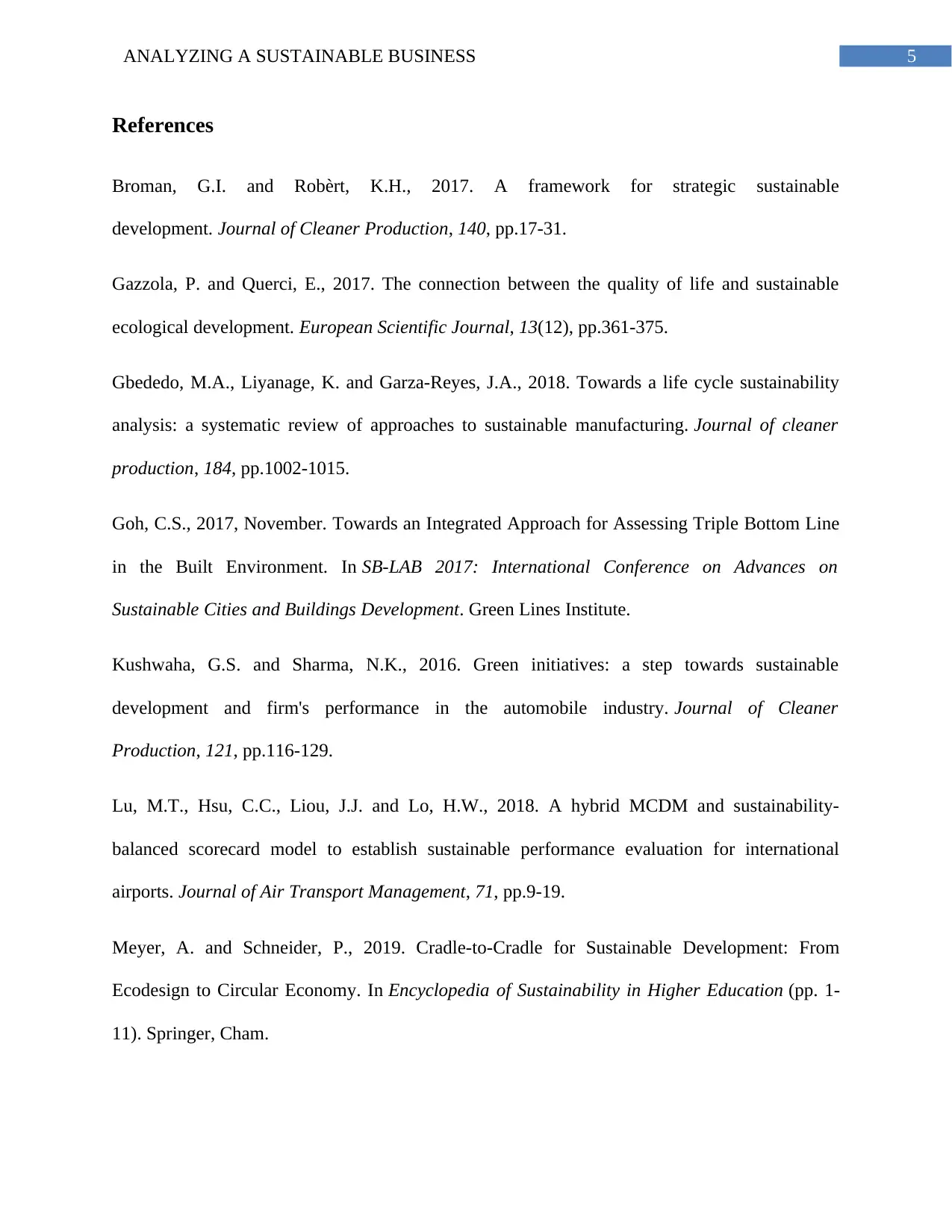
5ANALYZING A SUSTAINABLE BUSINESS
References
Broman, G.I. and Robèrt, K.H., 2017. A framework for strategic sustainable
development. Journal of Cleaner Production, 140, pp.17-31.
Gazzola, P. and Querci, E., 2017. The connection between the quality of life and sustainable
ecological development. European Scientific Journal, 13(12), pp.361-375.
Gbededo, M.A., Liyanage, K. and Garza-Reyes, J.A., 2018. Towards a life cycle sustainability
analysis: a systematic review of approaches to sustainable manufacturing. Journal of cleaner
production, 184, pp.1002-1015.
Goh, C.S., 2017, November. Towards an Integrated Approach for Assessing Triple Bottom Line
in the Built Environment. In SB-LAB 2017: International Conference on Advances on
Sustainable Cities and Buildings Development. Green Lines Institute.
Kushwaha, G.S. and Sharma, N.K., 2016. Green initiatives: a step towards sustainable
development and firm's performance in the automobile industry. Journal of Cleaner
Production, 121, pp.116-129.
Lu, M.T., Hsu, C.C., Liou, J.J. and Lo, H.W., 2018. A hybrid MCDM and sustainability-
balanced scorecard model to establish sustainable performance evaluation for international
airports. Journal of Air Transport Management, 71, pp.9-19.
Meyer, A. and Schneider, P., 2019. Cradle-to-Cradle for Sustainable Development: From
Ecodesign to Circular Economy. In Encyclopedia of Sustainability in Higher Education (pp. 1-
11). Springer, Cham.
References
Broman, G.I. and Robèrt, K.H., 2017. A framework for strategic sustainable
development. Journal of Cleaner Production, 140, pp.17-31.
Gazzola, P. and Querci, E., 2017. The connection between the quality of life and sustainable
ecological development. European Scientific Journal, 13(12), pp.361-375.
Gbededo, M.A., Liyanage, K. and Garza-Reyes, J.A., 2018. Towards a life cycle sustainability
analysis: a systematic review of approaches to sustainable manufacturing. Journal of cleaner
production, 184, pp.1002-1015.
Goh, C.S., 2017, November. Towards an Integrated Approach for Assessing Triple Bottom Line
in the Built Environment. In SB-LAB 2017: International Conference on Advances on
Sustainable Cities and Buildings Development. Green Lines Institute.
Kushwaha, G.S. and Sharma, N.K., 2016. Green initiatives: a step towards sustainable
development and firm's performance in the automobile industry. Journal of Cleaner
Production, 121, pp.116-129.
Lu, M.T., Hsu, C.C., Liou, J.J. and Lo, H.W., 2018. A hybrid MCDM and sustainability-
balanced scorecard model to establish sustainable performance evaluation for international
airports. Journal of Air Transport Management, 71, pp.9-19.
Meyer, A. and Schneider, P., 2019. Cradle-to-Cradle for Sustainable Development: From
Ecodesign to Circular Economy. In Encyclopedia of Sustainability in Higher Education (pp. 1-
11). Springer, Cham.
⊘ This is a preview!⊘
Do you want full access?
Subscribe today to unlock all pages.

Trusted by 1+ million students worldwide
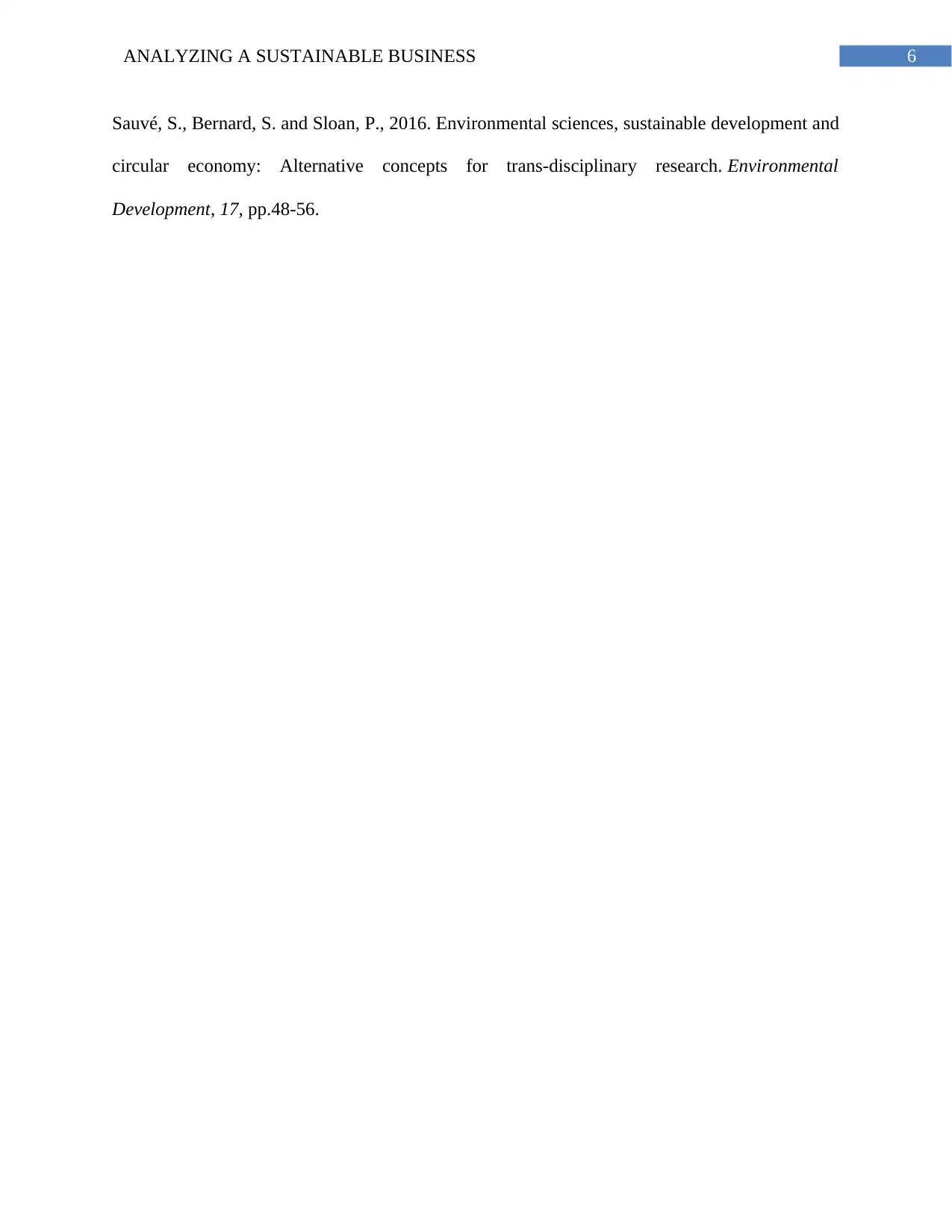
6ANALYZING A SUSTAINABLE BUSINESS
Sauvé, S., Bernard, S. and Sloan, P., 2016. Environmental sciences, sustainable development and
circular economy: Alternative concepts for trans-disciplinary research. Environmental
Development, 17, pp.48-56.
Sauvé, S., Bernard, S. and Sloan, P., 2016. Environmental sciences, sustainable development and
circular economy: Alternative concepts for trans-disciplinary research. Environmental
Development, 17, pp.48-56.
1 out of 7
Related Documents
Your All-in-One AI-Powered Toolkit for Academic Success.
+13062052269
info@desklib.com
Available 24*7 on WhatsApp / Email
![[object Object]](/_next/static/media/star-bottom.7253800d.svg)
Unlock your academic potential
Copyright © 2020–2025 A2Z Services. All Rights Reserved. Developed and managed by ZUCOL.





